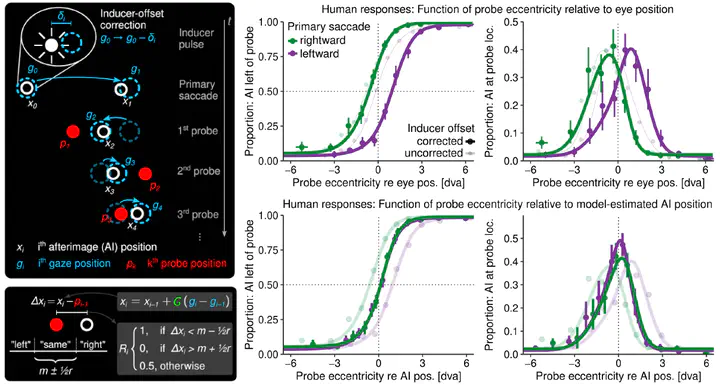High-fidelity but hypometric spatial localization of afterimages across saccades

Abstract
Humans typically perceive their visual world as stable and continuous, despite frequent shifts of the retinotopic reference frame caused by saccades. This visual stability is paralleled by the curious case of afterimage movement across saccades. Although retinotopically stable, afterimages appear to move in egocentric space wherever the eye moves. Even though this phenomenon has been known for centuries and could provide unique insights into visual stability, the mechanisms that give rise to afterimage movement remain unclear. By means of custom-built presentation hardware in complete darkness, observers viewed a bright foveal inducer pulse during fixation, executed a saccade to a previously cued location, and performed spatial localization of the emerging afterimage with respect to briefly flashed probes. This psychophysical tracking of afterimages was accompanied by eye tracking, allowing us to estimate afterimage-movement gain by fitting a dedicated computational model that simulated human localization responses. The extent of afterimage movement was accurately predicted by the size of eye movements with remarkably stable but significantly hypometric gains. Gains were unaffected by (even false) post-saccadic visual feedback and remained constant when saccade amplitudes were successfully adapted to lower gains. Irrespective of saccadic adaptation, afterimage-movement gains were inversely related to saccade gain – a finding that could be explained by a parsimonious efference-based model of head-centered visual localization. Our results suggest that afterimage movement across saccades is driven by feedforward prediction of the visual consequences of impending saccades and demonstrate the potential of the afterimage tracking technique for studying sensorimotor processes involved in active vision.
In low-light environments, brief high-intensity visual stimulation can induce long-lasting retinal afterimages. When observers then make eye movements to explore their visual environment, these afterimages – albeit fixed in the retinotopic frame of reference – appear to move in egocentric space wherever the eye moves. Even though this phenomenon has been known for centuries, the underlying computations remained unexplained. Tracking eye and afterimage positions simultaneously, we found that perceived afterimage position was accurately predicted by eye position across a variety of visuomotor conditions, whereby the eye movement’s size was however systematically underestimated by the visual system. Considering a parsimonious model of visual localization, afterimage movement can be understood as a consequence of feedforward predictions of the visual consequences of impending eye movements.